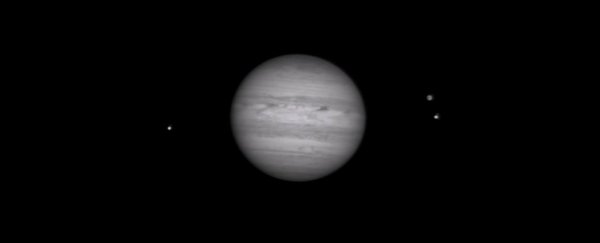Yesterday, we were lucky enough to witness an incredibly cool event in our cosmic neighbourhood: Jupiter's surface being smashed by an unidentified space rock, resulting in an unusually powerful impact for such a (relatively) small object.
And what makes the event even more awesome is the fact that we might not have even known about it, if it weren't for a pair of amateur astronomers who just happened to have their telescopes trained in on the largest planet in the Solar System at the time. So what does it take to capture footage this clear of an event happening more than 500 million km (310 million miles) away from Earth?
The footage below, captured by amateur astronomer Gerrit Kernbauer of Mödling, Austria on March 17, was the first video published of yesterday's event. He told Kelly Beatty from Sky and Telescope that it was all shot on his Skywatcher Newton 200/1000 Telescope, a $1,000 20-cm (8-inch) portable backyard telescope.
And it wasn't until Kernbauer decided to go back and process the footage captured more than a week prior that the world became aware that Jupiter had been hit. "The seeing was not the best, so I hesitated to process the videos," he said. "Nevertheless, 10 days later I looked through the videos and I found this strange light spot that appeared for less than one second on the edge of the planetary disc."

Pretty impressive, and absolutely mind-blowing that something so unfathomably far away can be seen so clearly.
And science loves corroborating evidence, which is why this second video of the same event is so valuable to astronomers who are now studying the collision and its aftermath.
Shot by Irish amateur astronomer John McKeon on a 27-cm (11-inch) Schmidt-Cassegrain telescope and ASI120MM monochrome astronomy camera, the footage is even clearer than the video above, thanks to McKeon applying a near-infrared filter to reduce Jupiter's brightness.
He told Sky and Telescope that he was making a 3.5-hour-long time-lapse video of Jupiter and its moons, "with a happy coincidence of the impact in the second-to-last capture of the night".

Both videos as you see them above have been processed from the raw footage by planetary imaging specialist Marc Delcroix, who makes the details of the collision more clear by altering the 1-second flash at the point of contact.
"But the timing is off a bit: in Kernbauer's video, the flash began at 00:18:35 UT, whereas in McKeon's the onset is 9 seconds later," Beatty points out, adding that, "Despite the time mismatch, the event appears to be real."
So take note, skywatchers - this could have been you. And even if you don't have a grand or more to spend on a backyard telescope, you don't even need it to be keeping a careful eye on the goings-on of the Solar System. Because this is what it looks like when you zoom in on the Moon using a much cheaper Nikon P900 camera:

Just promise you'll remember us when you become YouTube famous for capturing some incredible cosmic event?
